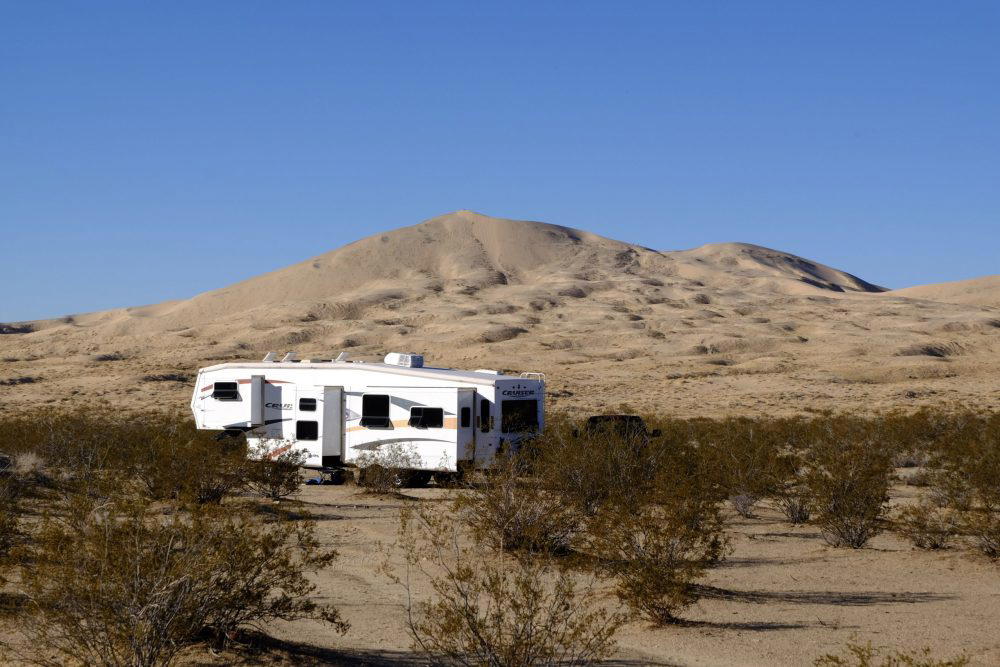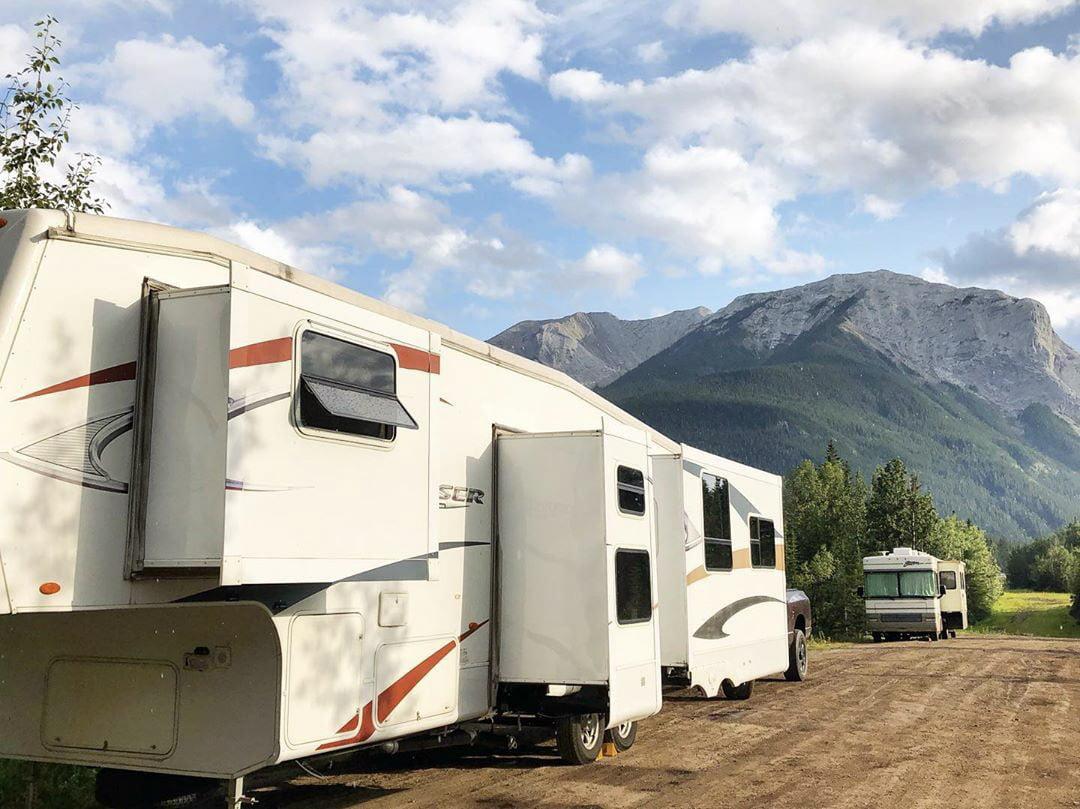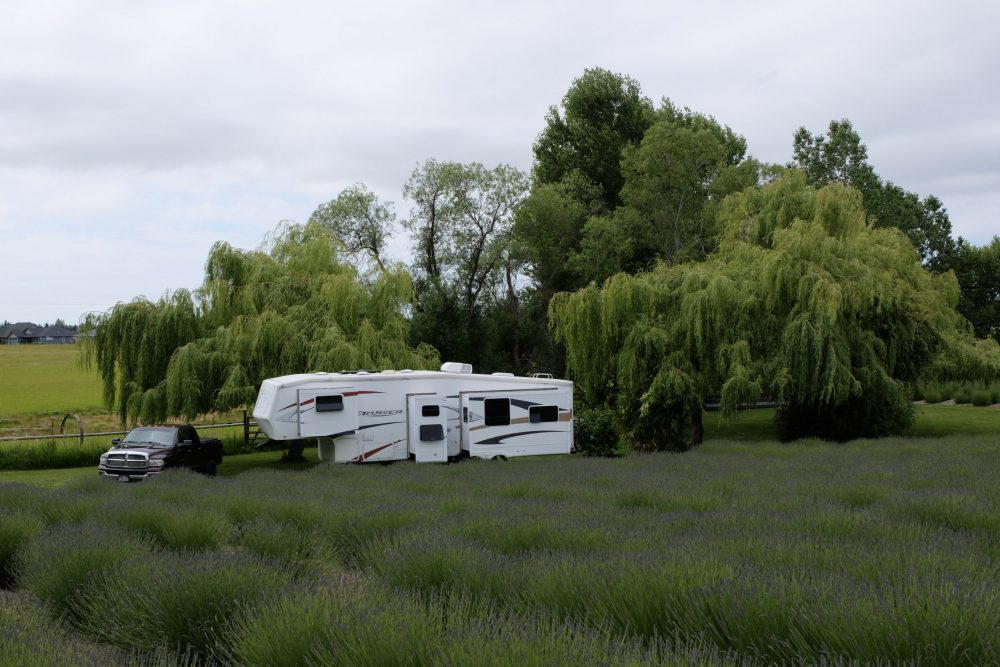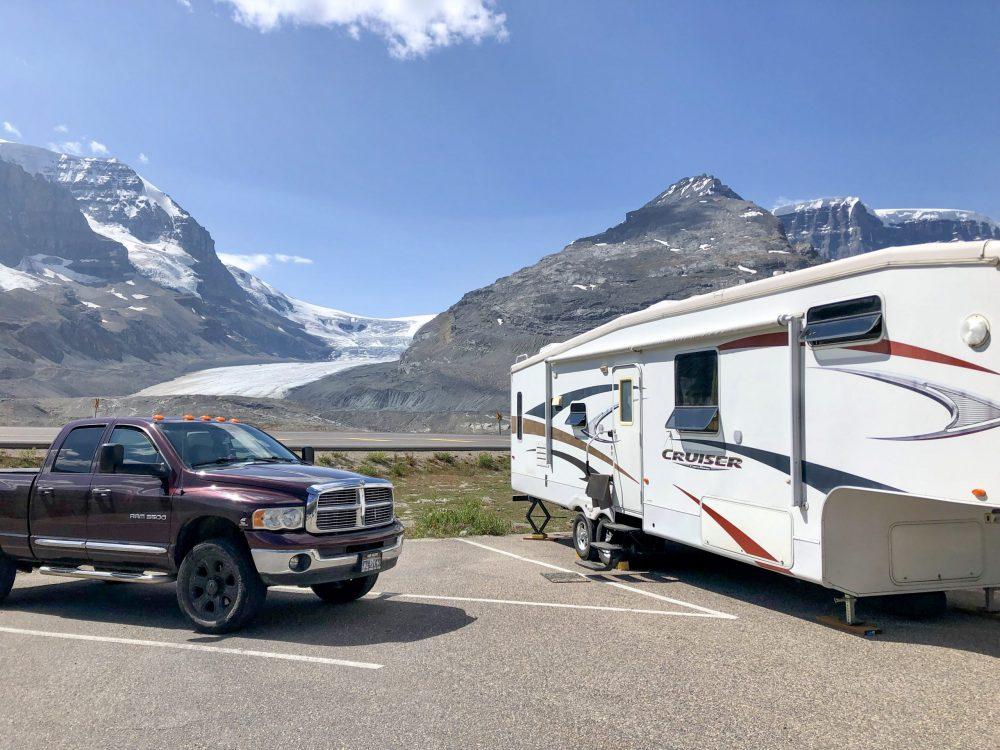RV camping is a wonderful way to connect with nature and enjoy the great outdoors. While staying at campgrounds and RV parks is great as they allow you to hook up to electricity, water, and sewage, they don’t let you truly get away from it all. If you want to go off-grid and camp where your only neighbors are the animals that live nearby, then boondocking is the way to go!

Boondocking in Mojave
What is Boondocking?
Boondocking, also known as dry camping, is RVing without hookups. That’s no electricity, no water, and no sewer hookups. Luckily, the vast majority of RVs are built for such a thing. Hence the holding tanks and batteries! Boondocking is generally done in primitive areas, such as BLM land, in designated campgrounds with no hookups, and overnight in parking lots or rest areas, usually on the way to and from a destination.
There are several pros to boondocking. First off, it’s generally free. Staying at an RV park can cost up to $100/night, while there is a ton of dispersed camping available at no cost. Just be aware of where you are camping as there might be a pass or permit that is required. Second, dry camping is camping the way it’s meant to be. Spotty cell service and not having unlimited power to watch the TV means more time to cook, read, relax and be outside. And third, boondocking truly allows for peace, quiet, and darkness. You aren’t nestled up against other RVs in every direction, you won’t hear your neighbor’s party until all hours of the night, and you’ll be able to see the night sky as never before.
While boondocking is terrific in many ways, it does take some preparation, planning, and thoughtfulness. Before camping, you need to figure out where you are going and what you’ll need. While camping, you need to take steps to limit the use of supplies so they’ll last. Here are some tips and tricks to ensure your camping trip goes smoothly!

Jasper
Finding Places to Camp
The first step is to find a place to camp: a legal, accessible place to camp. With RVing growing in popularity, more and more tools are available to make it easy. There are a number of apps and websites offering user-generated content on camping. Here are some great resources:
Campendium
This website and app offers a plethora of information on camping all over the country. Campers give information such as accessibility, site quality, cleanliness, noise level, cell coverage, pricing, reviews, and photos. Users give information based on first-hand experience. You’re able to filter your search by free camping only or find sites at campgrounds, State, and National parks too. Campendium is a great place to start when looking for a place to boondock!
iOverlander
Another excellent place for finding boondocking information is iOverlander. This app is not only great for finding where to camp but also shows other useful places such as dump stations, laundromats, mechanics, and more. iOverlander is a one-stop shop for all information needed for RVing. And, it has camping information worldwide!
Google Maps
When all else fails, and you can’t find a campsite through any other resources, take to Google Maps. Zoom in on the area you’d like to visit using satellite view. See if you’re able to find a location that can accommodate your rig and doesn’t discourage overnight parking. If you find a new campsite via Google Maps, add to places such as Campendium and iOverlander so that other campers can enjoy it!
Power
Staying Charged
Having electricity is one of the things that makes camping in an RV a little bit more like home than in a tent—having lights at night when inside the rig—using a pump for fresh water to the sink and toilet—charging devices. These little things are nice to have, especially if you are camping for more than just a night or two. To keep your RV powered, you need to make sure you have a good battery bank built with the best batteries for dry camping and a way to charge those batteries.
Batteries
Most RVs come with one or two 12V Lead-acid batteries. Basic batteries serve their purpose for a night or two of minimal usage but are not equipped to handle normal electrical usage for more than a few days. The fact that it’s recommended not to discharge more than 50-75% means by the time you use some stored power for a few lights one night, it’s time to charge the batteries again.
Upgrading your battery bank to lithium-ion is ideal for boondocking. Lithium-ion batteries for RVs are more powerful and last up to 4x longer than other batteries. They store energy longer, and you’re able to discharge to 80%. No matter what you are using to charge your batteries, it won’t matter if you don’t have the right bank. You’ll still struggle to keep enough charge for long enough to allow for everyday living.
Solar
To keep your battery bank charged while boondocking, you have a couple of options: the best being solar power. Adding solar panels to your rig is affordable and the highest performance charging solution. Going with a solar kit is the best way to ensure you have all of the components you need to outfit your RV with solar power. Here’s a chart for what solar panels you need by the size of RV & how many Dakota Lithium batteries you should have:
Size of RV | # of Batteries | Recommended Solar Panel Capacity
10′-14′ | 1-2x DL 100 Ah | 100-115-Watt Rooftop
15′-20′ | 1-2x DL 100 Ah | 150-170-Watt Rooftop
21′-30′ | 2x DL 100 Ah | 300 watt rooftop
31′-40′ | 2-4x DL 100 Ah | 500-600 watt rooftop
40’+ | 4-8x DL 100 Ah | 700-1100 watt rooftop
Conserving Electricity
Even with a powerful battery bank and solar or a generator, you need to be conservative with your electricity use to keep your batteries charged. Here are a few tips for conserving power while boondocking:
- Keep lights off during the day. Make sure if you have motion sensor lights, they are in the off position. Use lights only as needed at night. If you have an older rig, switch out incandescent bulbs with LEDs as they use roughly 80% less electricity.
- Don’t leave anything plugged in. If you use an appliance, say a coffee maker in the morning, make sure to unplug it when you are done. Better yet, try not to use appliances while boondocking! Opt for french press coffee. Or, cook on the stove rather than the microwave or crockpot.
- Be smart about charging devices. If you need a phone, laptop, or other electronic devices while camping, think about the amount of energy it’s pulling while plugged in. Consider charging devices in the morning if you’re running off solar so you’re able to take advantage of fully charged batteries. If you will be driving in a vehicle while camping, charge devices there rather than in the RV.
- Don’t use the RV systems unless you have to. This means use the furnace only if necessary. The heater runs off gas but does require electricity to start. Chances are you won’t have the power necessary to start the AC, so opt for a battery-powered or 12V fan instead. Keep the water pump and water heater off except for when in use.
- Spend your time outside, because that’s what boondocking is all about! There is no better way to conserve electricity than not being in the RV. Cook your meals on a grill outdoors. Use the breeze and shade of a tree to keep you cool. Use the campfire for light and warmth. Enjoy your temporary backyard!

Water
Nothing is going to bring your dry camping fun to an end quicker than running out of fresh water. An average freshwater tank holds 20-100 gallons of fresh water. A Class A will hold between 75-100 gallons. Class Cs will hold 35-60 gallons, Class Bs will hold around 20-40, and fifth-wheel trailers hold about 60-80 gallons. Smaller trailers hold 40-60 gallons. While this sounds like a lot, if you aren’t mindful of water usage, it can disappear quickly.
Did you know it can take about 20 gallons of water to wash one load of dishes? That’s all of your fresh water in just a matter of a few days! Opt for paper plates and bowls while boondocking. Also, prep food ahead of time if possible, and meal plan for breakfasts, lunches, and dinners that don’t require multiple cooking pots and pans. Cook outside on a grill vs. in a skillet on the stove.
For the inevitable dish or two, use dish tubs, one filled with a bit of soapy water for washing, and one filled with a little clean water for rinsing. This will use way less water than letting the faucet run. If you’re using biodegradable soap, throw your dishwater out the front door rather than down the drain when you’re done to save precious grey tank space!
To conserve water in the fresh tank, don’t use it for drinking. It’s much easier to bring additional water for drinking than to fill up the toilet for flushing! Simply getting gallons of water at the store works or for less waste, a bladder or 5 gallon cube are great options.
Other than doing the dishes, showering is one of the quickest ways to go through water. You won’t have the luxury of showering every day while dry camping, but if you do need to rinse off once or twice, take a military-style shower. This means turning the water off while lathering up with shampoo or soap and turning the water back on just to rinse. There are shower heads available to make this easy to do that won’t require reconfiguring the temperature mid-shower. If you are okay with going longer without showering, purchase some wet bathing wipes to freshen up without using any water at all!
While having a toilet aboard is one of the best things about RV camping, flushing does require water (unless you have a composting toilet). Be conservative with flushes. If it’s yellow, let it mellow. Men should take advantage of the outdoors as much as possible. For when you do need to flush down the brown, fill the bowl beforehand so less water is needed during the flush.
Tanks
Conserving water using the methods above will ensure you have enough gray tank storage available. If you are mindful while washing dishes, showering, and brushing your teeth, you shouldn’t have to worry about filling up.
If you are conservative with toilet usage, you should be okay with the black tank also. Again, men should take advantage of the great outdoors. For women, use as little toilet paper as possible, and if you are comfortable with it, dispose of it in a trash can rather than throwing it in the black tank. As for toilet paper, make sure you are choosing septic safe or an RV-specific product.
Gray and black tanks should be dumped before boondocking while the fresh water tank should be filled. Many gas stations and truck stops have dump stations and potable water. Apps like Campendium and iOverlander are great resources for finding dump stations all over the country. After camping, find a dump station nearby to lighten the load ASAP. When boondocking for a long period of time, a portable waste holding tote can be used to empty tanks without having to completely pack up camp just to run to the dump station.

Athabasca Glacier
While boondocking may require a little bit more planning than staying at a park with full hookups, you can’t beat the experience. With these tips and tricks, camping in the wild should be easy and enjoyable. Get out there, relax, and have fun!
About the author: Jessica Baker has been full-time RVing since 2018. She has traveled extensively throughout the U.S. and Canada in her fifth-wheel RV turned tiny home on wheels with her husband, two kids, and three cats. You can find out more about her travels at BoundlessBakers.com and follow along on her adventures on Instagram.